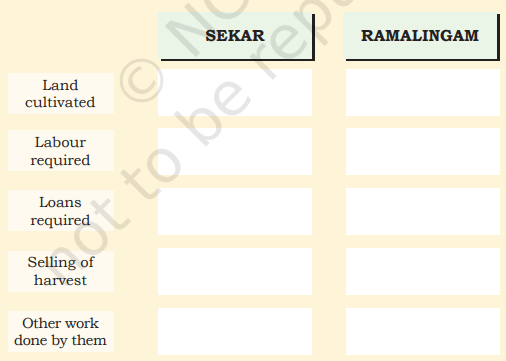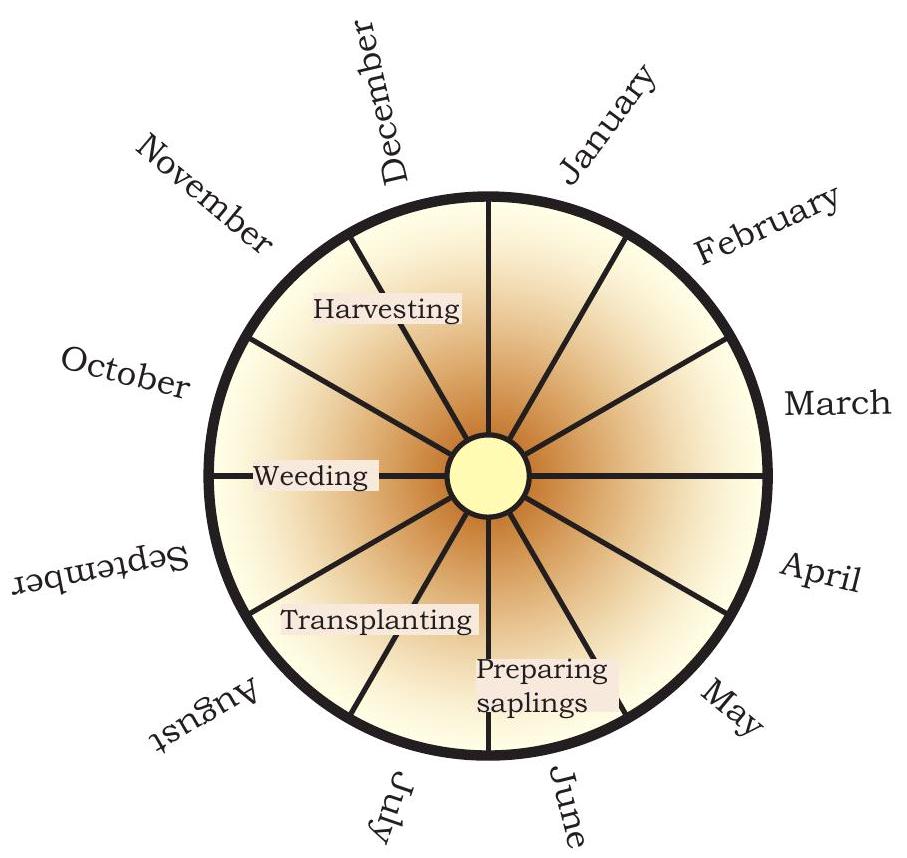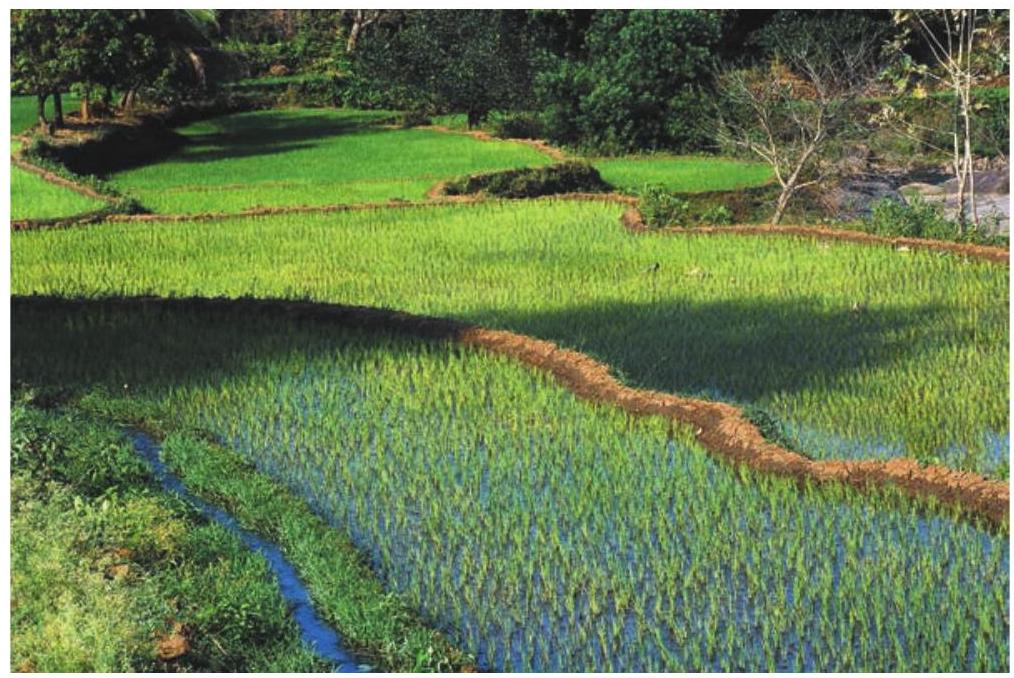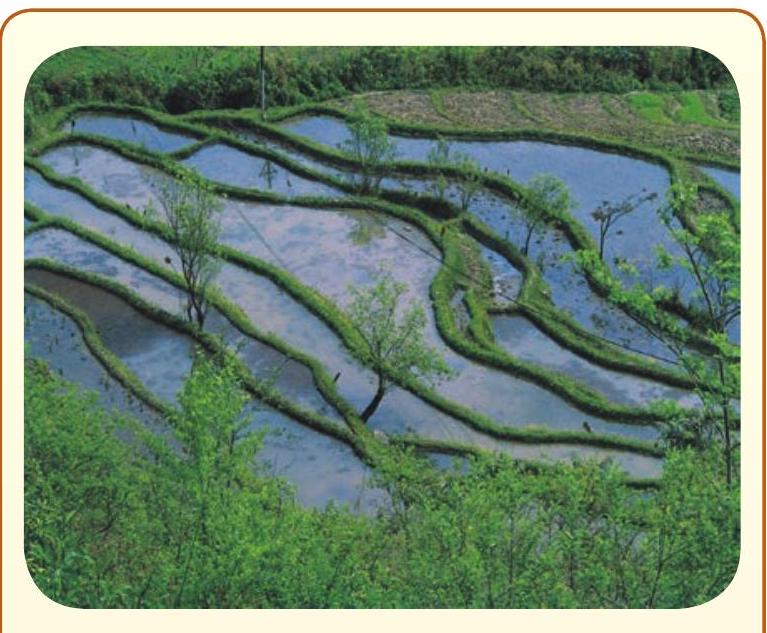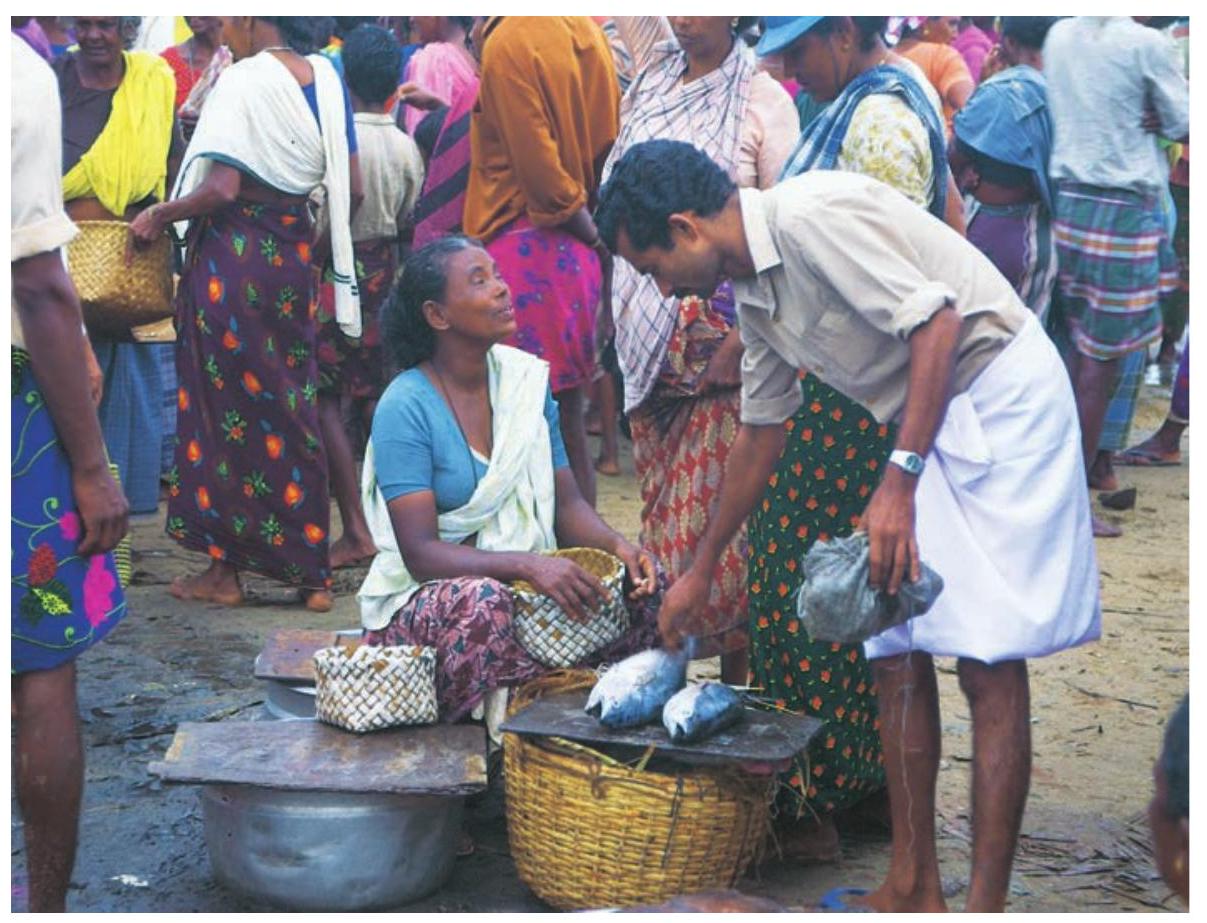Chapter 07 Rural Livelihoods
In the first chapter we looked at the many kinds of diversity in our lives. We also explored how living in different regions has an effect on the work people do, the kinds of plants, trees, crops or things that become important to them. In this chapter we will look at the different ways in which people earn their living in villages. And here too, as in the first two chapters, we will examine whether people have equal opportunities to earn a living. We will look at the similarities in their life situations and the problems that they face.
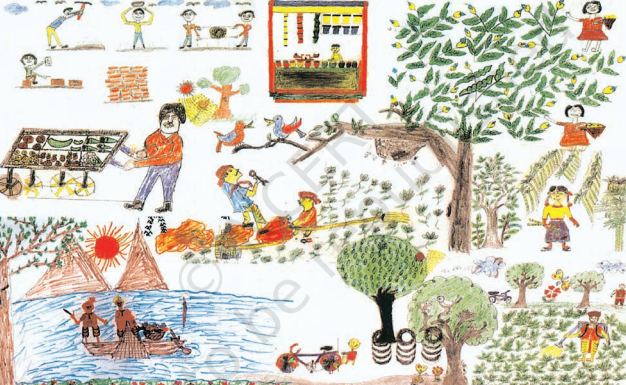
1. Describe the work that you see people doing in the above pictures.
2. Identify the different types of work that are related to farming and those that are not. List these in a table.
3. In your notebook draw some pictures of work that you have seen people do in rural areas and write a few sentences that describe the work
Kalpattu village
Kalpattu is a village that’s close to the sea coast in Tamil Nadu. People here do many kinds of work. As in other villages, here too there is non-farm work such as making baskets, utensils, pots, bricks, bullock-carts etc.
$\quad$ There are people who provide services such as blacksmiths, nurses, teachers, washermen, weavers, barbers, cycle repair mechanics and so on. There are also some shopkeepers and traders. In the main street, which looks like a bazaar, you
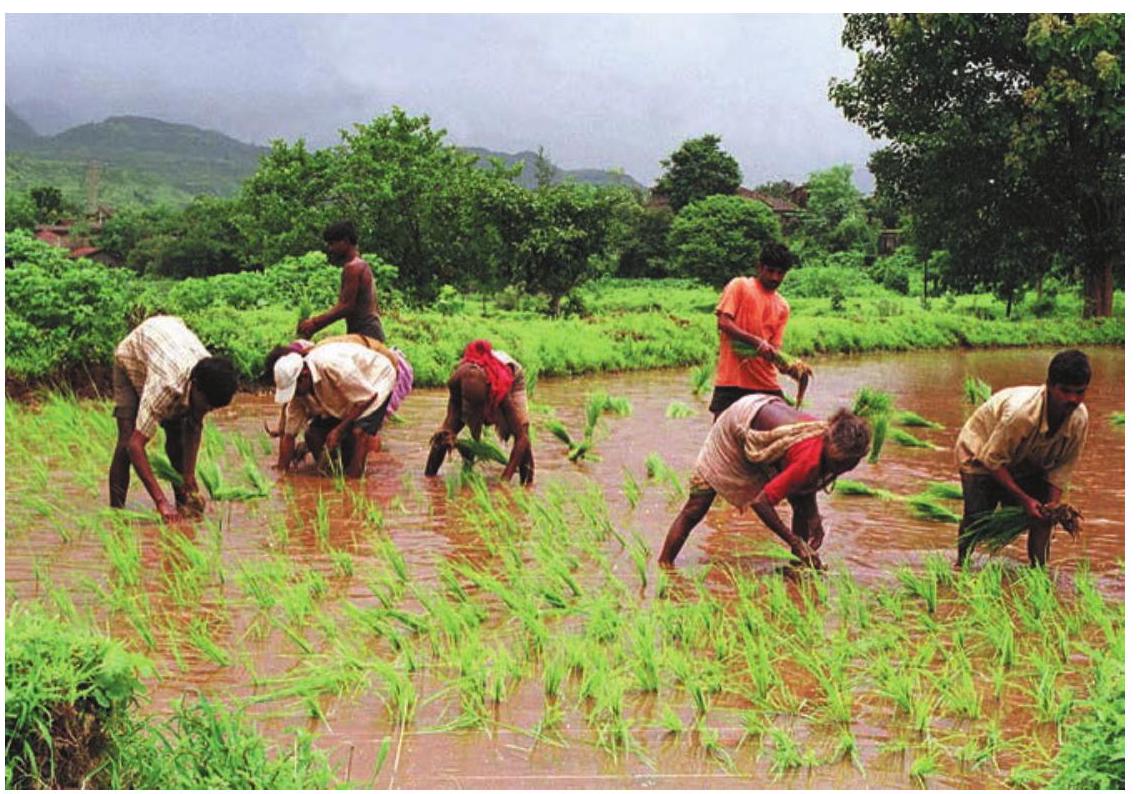
Transplanting paddy is back-breaking work.
will find a variety of small shops such as tea shops, grocery shops, barber shops, a cloth shop, a tailor and two fertiliser and seed shops. There are four teashops, which sell tiffin such as idli, dosai and upama in the morning and snacks like vadai, bonda and mysorepak in the evening. Near the teashops in a corner lives a blacksmith family whose home serves as their workshop. Next to their home is a cycle hire and repair shop. Two families earn a living by washing clothes. There are some people who go to the nearby town to work as construction workers and lorry drivers.
$\quad$ The village is surrounded by low hills. Paddy is the main crop that is grown in irrigated lands. Most of the families earn a living through agriculture.
$\quad$ There are some coconut groves around. Cotton, sugar cane and plantain are also grown, and there are mango orchards. Let us now meet some people who work in the fields in Kalpattu and see what we can learn about farming from them.
Thulasi
All of us here work on Ramalingam’s land. He has twenty acres of paddy fields in Kalpattu. Even before I was married I used to work on paddy fields in my parental village. I work from 8.30 in the morning till 4.30 in the evening and Karuthamma, Ramalingam’s wife, supervises us.
$\quad$ This is one of the few times in the year that I find regular work. Now I am transplanting the paddy, when the plants have grown a bit Ramalingam will call us again for weeding and then finally once again for the harvesting.
$\quad$ When I was young I could do this work with no difficulty. But now as I grow older I find bending for long hours with my feet in water very painful. Ramalingam pays Rs 40 per day. This is a little less than what labourers get in my home village, but I come here because I can depend on him to call me whenever there is work. Unlike others, he does not go looking for cheaper labour from other villages.
$\quad$ My husband, Raman is also a labourer. We don’t own any land. During this time of the year he sprays pesticides. When there is no work on
Based on the above diagram would you say that Thulasi earns money throughout the year?
the farm he finds work outside, either loading sand from the river or stone from the quarry nearby. This is sent by truck to be used in nearby towns to make houses.
$\quad$ Apart from working on the land, I do all the tasks at home. I cook food for my family, clean the house and wash clothes. I go with other women to the nearby forest to collect firewood. About one kilometre away we have a village borewell from where I fetch water. My husband helps in getting materials such as groceries for the house.
$\quad$ Our school-going daughters are the joy of our lives. Last year, one of them fell ill and had to be taken to the hospital in town. We had to sell our cow to pay back the money we borrowed from Ramalingam for her treatment.
1. Describe the work that Thulasi does. How is it different from the work Raman does?
2. Thulasi gets paid very little money for the work she does. Why do you think agricultural labourers like her are forced to accept low wages?
3. In what ways would her way of earning a living have been different if Thulasi owned some farm land? Discuss.
4. What are the crops grown in your region or nearby rural area? What kinds of work do agricultural labourers do?
$\quad$ As you saw in Thulasi’s story poor families in rural areas often spend a lot of time every day collecting firewood, getting water and grazing their cattle.
$\quad$ Even though they do not earn any money from these activities they have to do them for the household. The family needs to spend time doing this as they are not able to survive on the little money they earn.
$\quad$ Nearly two-fifth of all rural families are agricultural labourers in our country. There are some who have small plots of land while others like Thulasi are landless.
$\quad$ Not being able to earn money throughout the year forces people in many rural areas to travel long distances in search of work. This travel, or migration, takes place during particular seasons.
Sekar
We have to carry this paddy to our house. My family has just finished
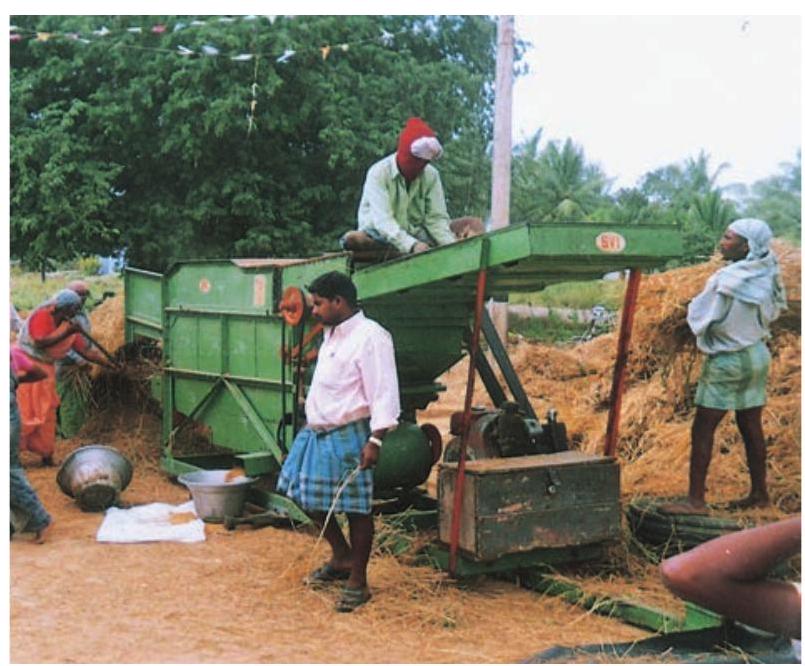
harvesting our field. We don’t own much land, only two acres. We manage to do all the work on our own. At times, especially during the harvest I take the help of other small farmers and in turn help them harvest their field.
$\quad$ The trader gave me seeds and fertilisers as a loan. To pay back this loan I have to sell my paddy to him at a somewhat lower price than what I would get in the market. He has sent his agent to remind farmers who have taken loans that they will sell the paddy only to him.
$\quad$ I will probably get 60 bags of paddy from my field. Some of this I will sell to settle the loan. The rest will be used in my home. But whatever I have will last only eight months. So I need to earn some money. I work in Ramalingam’s rice mill. Here I help him collect paddy from other farmers in the neighbouring villages.
$\quad$ We also have a hybrid cow, whose milk we sell in the local milk cooperative. This way we get a little extra money for our everyday needs.
On being in Debt
As you’ve read above, very often farmers like Sekar need to borrow money to purchase basic things like seeds, fertilisers and pesticides. Often they borrow this money from moneylenders. If the seeds are not of good quality or pests attack their crop there can be a major crop failure.
$\quad$ The crops can also be ruined if the monsoon does not bring enough rain. When this happens farmers sometimes are unable to pay back their loans. And, for the family to survive, they may even have to borrow more money. Soon the loan becomes so large that no matter what they earn, they are unable to repay.
$\quad$ This is when we can say they are caught in debt. In recent years this has become a major cause of distress among farmers. In some areas this has also resulted in many farmers committing suicide.
1. What work does Sekar’s family do? Why do you think Sekar does not usually employ labourers for doing farming work?
2. Why does Sekar not go to the town market to get a better price for his paddy?
3. Sekar’s sister Mina had also taken a loan from the trader. She does not want to sell her paddy to him but she will pay back her loan. Write an imaginary conversation between Mina and the trader’s agent and the arguments given by each person.
4. What are the similarities and differences between Sekar’s and Thulasi’s lives? Your answer could be based on the land that they have, their need to work on the land that belongs to others, or loans that they need and their earnings.
Transplanted paddy growing in a few of Ramalingam’s 20 acres. A result of hard labour performed by agricultural workers like Thulasi.
Ramalingam and Karuthamma
In addition to land, Ramalingam’s family owns a rice mill and a shop selling seeds, pesticides etc. For the rice mill they used some of their own money and also borrowed from the government bank. They buy paddy from within the village and from surrounding villages. The rice that is produced in the mill is sold to traders in nearby towns. This gives them a substantial income.
Read again Sekar’s and Thulasi’s accounts. What do they say about Ramalingam, the large farmer? Together with what you have read fill in the details below:
1. How much land does he have?
2. What does Ramalingam do with the paddy grown on his land?
3. Apart from farming how else does he earn?
Terrace Farming in Nagaland
This is a village called Chizami which is in Phek district in Nagaland. The people of this village belong to the Chakhesang community. They do ’terrace’ cultivation.
This means that the land on a hill slope is made into flat plots and carved out in steps. The sides of each plot are raised in order to retain water. This allows water to stand in the field, which is best for rice cultivation.
The people of Chizami have their own individual fields. But, they also work collectively in each other’s fields. They form groups of six or eight and take an entire mountainside to clean the weeds on it.
Each group eats together once their work for the day is over. This goes on for several days until the work is completed.
Agricultural Labourers and Farmers in India
In Kalpattu village there are agricultural labourers like Thulasi, and many small farmers like Sekar, and a few big farmers like Ramalingam. In India nearly two out of every five rural families are agricultural labourer families. All of them depend on the work they do on other people’s fields to earn a living. Many of them are landless and others may own very small plots of land.
$\quad$ In the case of small farmers like Sekhar their land is barely enough to meet their needs. In India 80 per cent of farmers belong to this group. Only 20 per cent of India’s farmers are like Ramalingam. These large farmers cultivate most of the land in the villages. A large part of their produce is sold in the market. Many of them have started other businesses such as shops, moneylending, trading, small factories etc.
From the figures given above would you say that a majority of the country’s farmers are quite poor? What do you think can be done to change this situation?
$\quad$ We have looked at farming in Kalpattu. Apart from farming, many people in rural areas depend upon collection from the forest, animal husbandry, dairy produce, fishing etc. For example, in some villages in central India, both farming and collection from the forest are important sources of livelihood. Collecting mahua, tendu leaves, honey, to be sold to traders, is an important source of additional income.
$\quad$ Similarly selling milk to the village cooperative society or taking milk to the nearby town may be the main source of livelihood for some families. In the coastal areas, we find fishing villages. Let us find out more about the lives of a fishing family by reading about Aruna and Paarivelan who live in Pudupet, a village close to Kalpattu
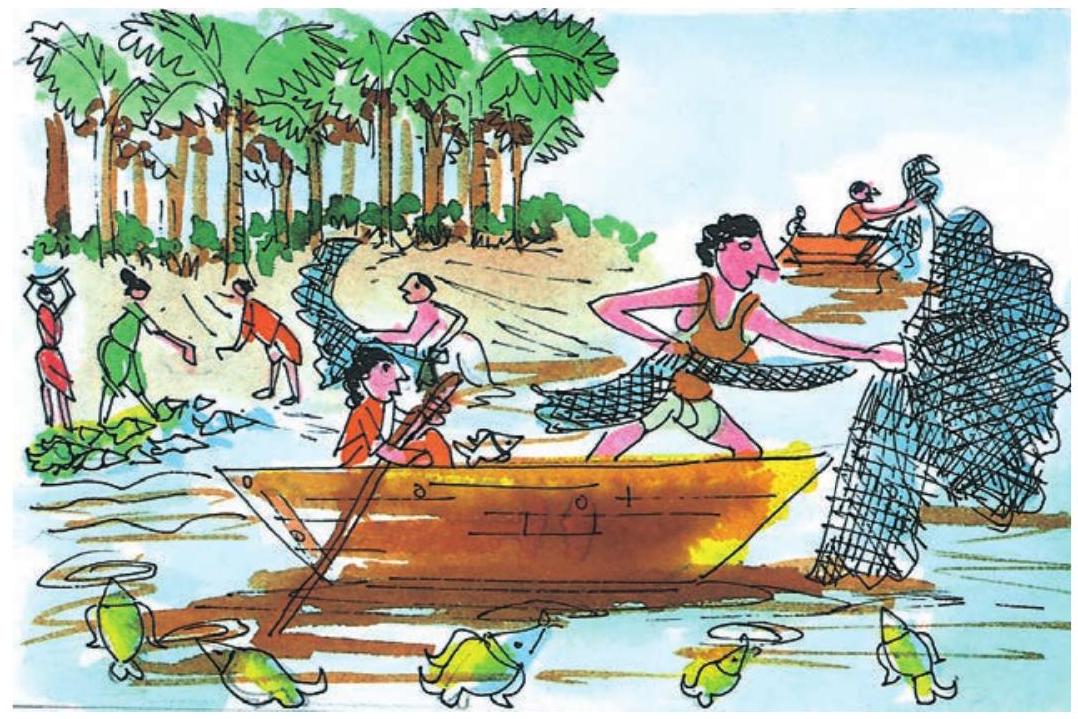
Aruna and Paarivelan
Not very far from Kalpattu is the village of Pudupet. People here earn their living by fishing. Their houses are close to the sea and one finds rows of catamarans and nets lying around. At about 7 o’clock in the morning there is a lot of activity on the beach. This is the time when the catamarans return with their catch and women gather to buy and sell fish.
Fisher-woman selling the catch at the local market.
$\quad$ My husband Paarivelan, my brother and my brotherin-law returned late today. I was very worried. They go to the sea together in our catamaran. They said they were caught in a storm. I have kept aside some fish for the family. I will auction the rest. The money I get from the auction will be divided into four shares. One each for each person who went fishing and the fourth one is for the equipment. Since we own the catamaran, engine and nets, we get that share too. We have taken a loan from a bank and purchased an engine, which is fixed on to the catamaran. Now they can go far into the sea so that they can get a better catch.
$\quad$ The women who buy fish here will carry them in baskets to be sold in nearby villages. Then there are others like traders who buy for the shops in the town. I’ll only finish this auction by noon. In the evening my husband and our relatives will untangle and repair our nets. Early tomorrow morning around 2 a.m. they will set out to sea again. Every year, for at least about four months during the monsoon, they cannot go to the sea because this is when the fish breed. During these months we survive by borrowing from the trader. Because of this, later on we are forced to sell the fish to that trader, and cannot do our auction. Those lean months are the most difficult. Last year we suffered a lot because of the tsunami.
Rural Livelihoods
People in rural areas earn their living in various ways. Some work on farms while others earn their living on non- farm activities. Working on farms involves operations such as preparing the land, sowing, weeding and harvesting of crops. We depend on nature for the growth of these crops. Hence life
1. Why do both Sekar’s and Aruna’s families have to borrow? What similarities and differences do you find?
2. Have you heard of tsunami? What is this and what damage do you think it might have done to the life of fishing families like Aruna’s?
revolves around certain seasons. People are busy during sowing and harvesting and less so at other times. Rural people in different regions of the country grow different crops. However, we do find similarities in their life situations and in the problems that they face.
$\quad$ How people are able to survive or earn will depend upon the land that they cultivate. Many depend on these lands for work as labourers. Most farmers grow crops both for their own requirements and also to sell in the market. Some have to sell to traders from whom they have borrowed money. For their survival, many families need to borrow money for their work or when no work is available. There are some families in rural areas which thrive on large acres of lands, business and other activities. However, most small farmers, agricultural labourers, fishing families, crafts persons in the villages do not find enough work to keep them employed throughout the year.
QUESTIONS
1. You have probably noticed that people in Kalpattu are engaged in a variety of non-farm work. List five of these.
2. List the different types of people you read about in Kalpattu who depend on farming. Who is the poorest among them and why?
3. Imagine you are a member of a fishing family and you are discussing whether to take a loan from the bank for an engine. What would you say?
4. Poor rural labourers like Thulasi often do not have access to good medical facilities, good schools, and other resources. You have read about inequality in the first unit of this text. The difference between her and Ramalingam is one of inequality. Do you think this is a fair situation? What do you think can be done? Discuss in class.
5. What do you think the government can do to help farmers like Sekar when they get into debt? Discuss.
6. Compare the situation of Sekar and Ramalingam by filling out the following table:
